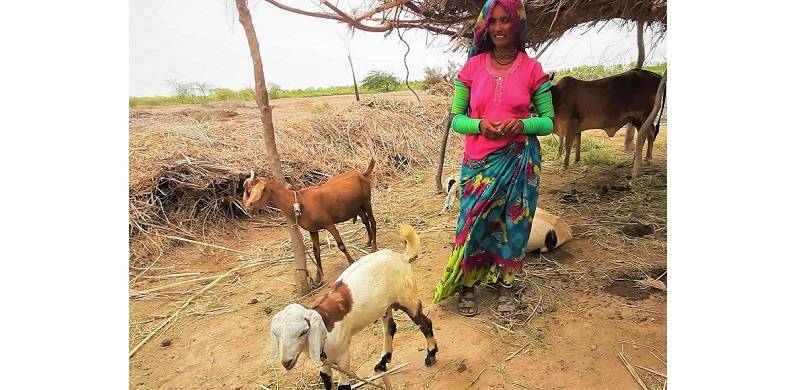
According to the Pakistan Economic Survey (2021), 24.3%, i.e. one in every four Pakistanis, lives below the national poverty line. The situation has been further exacerbated by the COVID-19 pandemic, with the working population declining from 55.74 to 35.04 million. In a recent government meeting, the Pakistan Institute of Development Economics (PIDE) informed that unemployment ratio in the country had reached as high as 16%, with 40% of educated women currently jobless. The situation continues to look grim, as for the coming years macroeconomic models predict an increase in households falling below the poverty.
With a largely rural population, rural poverty figures in Pakistan are higher than urban ones. Yet, rural development tends to lag across the country, with even basic necessities and government facilities usually absent, inaccessible or not fully functional. Though a large majority of the rural population is dependent upon agriculture and livestock for its livelihood, mostly as sharecroppers and farm labourers, investments in these sectors remains low. As a result, productivity remains low, spelling trouble for the 38.5% of the overall country’s labour force.
As per Labour Force Survey 2018-2019, the working age population for both sexes is almost same at 77.4 million and 76.1 million for males and females respectively. However, females are twice as likely to be engaged in vulnerable employment, with a much larger population engaged in the rural informal sector than their rural male or urban female counterparts. Women in agriculture, who make up 65% of all working women in the country according to formal figures, thus remain particularly vulnerable. Their contribution in the food production process is not properly acknowledged – on the contrary, they are largely underpaid, suffer from greater time poverty, and are far more vulnerable to exploitation than men.
Devising effective rural development efforts – targeting poverty in general and women’s uplift and empowerment in particular – has been a challenge for successive governments and development organisations over the decades. One effort being undertaken with the support of the Sindh government and funding from the European Union is the Sindh Union Council and Community Economic Strengthening Support (SUCCESS) Programme and People’s Poverty Reduction Programme (PPRP) that is being implemented in 20 districts of the province. Among other aspects of the programme, one intervention seeks to provide female Local Support Organisations (LSOs) with a revolving fund, known as the Community Investment Fund (CIF), that is to be utilised by members for building economic assets for income generation, based on a proposed micro-investment plan by the poor households. Given the rural environment, micro-investment plans usually focus upon livestock, agriculture, or micro-enterprise activities.
A recently conducted third-party survey into the impact of Income Generating Grants (IGGs) and CIF revealed that 82.4% of women chose to invest in livestock activities, 7.9% in agriculture, and 9.7% in village level micro-enterprise. Of the women who invested in livestock, the average net profits from CIF and IGG investments stood at PKR 12,702 per annum. Post CIF/IGG, 92% households reported owning at least one animal, with current market value of animals owned – PKR 33,098 with one cycle of CIF and PKR 45,918 with two cycles of CIF. The average herd size previously owned was 1.67 for CIF, which subsequently increased to 1.85 after a one-time CIF and 2.19 for multiple loans. For those who invested in agriculture – for instance, to purchase seeds or fertilizer using CIF financing – net profits were PKR 19,836 per production season. As for the profits of enterprises set up with CIF investments, on average, beneficiaries earned a profit of PKR 2,030 per month. The overall estimated contribution of CIF/IGG investments to the monthly household income was estimated at 11%.
In all cases, larger gains were found to be enjoyed by households who had completed more than one round of CIF. The difference in returns between one versus multiple CIF cycles is the largest for net profits earned through the sale of livestock, mainly because multiple loans directly translate into a larger herd size in most cases. For enterprises, the current value of the business increases by more than 50% in case of multiple loan cycles.
With regards to poverty graduation, a comparison of the poverty scorecard pre- and post- CIF funding was made. While a direct causation cannot be determined, results did indicate that 42% of households managed to improve their poverty score during the period. Much of this was due to asset creation due to the CIF financing. Since the funding was geared specifically towards women, these beneficiaries reported greater empowerment in terms of intra-household decision making and intra-village mobility.
Under social protection programmes of the government, unconditional cash grants are provided to targeted poor households. For example, think of the Benazir Income Support Programme (BISP, or Ehsaas Kafalat). Most of these grants are used for household consumption. However, under the PPRP and SUCCESS Programmes, IGG grants and CIF loans are used for economic asset creation and income generation. CIF, while directly contributing to increasing household incomes, also strengthens community institutions and their sustainability.
Given limited resources, the CIF thus provides an example of tackling poverty and unemployment and uplifting rural women. Till date CIF loans worth Rs. 1,502 million have been given to a total of 76,948 households. Under the EU-SUCCESS programme, community organisations are free to charge a small processing fee from members, thus not only meeting operational expenses but also using surplus to top up the CIF capital fund.
Rural women are looking for opportunities to unleash their own potential. They want opportunities, not handouts.
With a largely rural population, rural poverty figures in Pakistan are higher than urban ones. Yet, rural development tends to lag across the country, with even basic necessities and government facilities usually absent, inaccessible or not fully functional. Though a large majority of the rural population is dependent upon agriculture and livestock for its livelihood, mostly as sharecroppers and farm labourers, investments in these sectors remains low. As a result, productivity remains low, spelling trouble for the 38.5% of the overall country’s labour force.
As per Labour Force Survey 2018-2019, the working age population for both sexes is almost same at 77.4 million and 76.1 million for males and females respectively. However, females are twice as likely to be engaged in vulnerable employment, with a much larger population engaged in the rural informal sector than their rural male or urban female counterparts. Women in agriculture, who make up 65% of all working women in the country according to formal figures, thus remain particularly vulnerable. Their contribution in the food production process is not properly acknowledged – on the contrary, they are largely underpaid, suffer from greater time poverty, and are far more vulnerable to exploitation than men.
Devising effective rural development efforts – targeting poverty in general and women’s uplift and empowerment in particular – has been a challenge for successive governments and development organisations over the decades. One effort being undertaken with the support of the Sindh government and funding from the European Union is the Sindh Union Council and Community Economic Strengthening Support (SUCCESS) Programme and People’s Poverty Reduction Programme (PPRP) that is being implemented in 20 districts of the province. Among other aspects of the programme, one intervention seeks to provide female Local Support Organisations (LSOs) with a revolving fund, known as the Community Investment Fund (CIF), that is to be utilised by members for building economic assets for income generation, based on a proposed micro-investment plan by the poor households. Given the rural environment, micro-investment plans usually focus upon livestock, agriculture, or micro-enterprise activities.
“Based on my MIP, I received a Rs15,000 CIF loan and bought a goat, which later delivered two kids. I sold the Billy-goat and returned the CIF on yearly installment. In the second phase, I received a Rs20,000 CIF loan and bought three goats. After a year, I sold two of them for Rs26,000, returned Rs20,000 to CIF and spent the rest of the amount on meeting household expenditures, e.g., education, health, etc. Now I have applied for a third CIF loan, which again I will invest in goats,” says Samina, a CIF beneficiary from district Tando Allahyar. She further adds: “In our community all the members who have received CIF had earned a benefit from it.”
A recently conducted third-party survey into the impact of Income Generating Grants (IGGs) and CIF revealed that 82.4% of women chose to invest in livestock activities, 7.9% in agriculture, and 9.7% in village level micro-enterprise. Of the women who invested in livestock, the average net profits from CIF and IGG investments stood at PKR 12,702 per annum. Post CIF/IGG, 92% households reported owning at least one animal, with current market value of animals owned – PKR 33,098 with one cycle of CIF and PKR 45,918 with two cycles of CIF. The average herd size previously owned was 1.67 for CIF, which subsequently increased to 1.85 after a one-time CIF and 2.19 for multiple loans. For those who invested in agriculture – for instance, to purchase seeds or fertilizer using CIF financing – net profits were PKR 19,836 per production season. As for the profits of enterprises set up with CIF investments, on average, beneficiaries earned a profit of PKR 2,030 per month. The overall estimated contribution of CIF/IGG investments to the monthly household income was estimated at 11%.
42% of households managed to improve their poverty score during the period. Much of this was due to asset creation due to the CIF financing
In all cases, larger gains were found to be enjoyed by households who had completed more than one round of CIF. The difference in returns between one versus multiple CIF cycles is the largest for net profits earned through the sale of livestock, mainly because multiple loans directly translate into a larger herd size in most cases. For enterprises, the current value of the business increases by more than 50% in case of multiple loan cycles.
With regards to poverty graduation, a comparison of the poverty scorecard pre- and post- CIF funding was made. While a direct causation cannot be determined, results did indicate that 42% of households managed to improve their poverty score during the period. Much of this was due to asset creation due to the CIF financing. Since the funding was geared specifically towards women, these beneficiaries reported greater empowerment in terms of intra-household decision making and intra-village mobility.
Under social protection programmes of the government, unconditional cash grants are provided to targeted poor households. For example, think of the Benazir Income Support Programme (BISP, or Ehsaas Kafalat). Most of these grants are used for household consumption. However, under the PPRP and SUCCESS Programmes, IGG grants and CIF loans are used for economic asset creation and income generation. CIF, while directly contributing to increasing household incomes, also strengthens community institutions and their sustainability.
Given limited resources, the CIF thus provides an example of tackling poverty and unemployment and uplifting rural women. Till date CIF loans worth Rs. 1,502 million have been given to a total of 76,948 households. Under the EU-SUCCESS programme, community organisations are free to charge a small processing fee from members, thus not only meeting operational expenses but also using surplus to top up the CIF capital fund.
Rural women are looking for opportunities to unleash their own potential. They want opportunities, not handouts.

